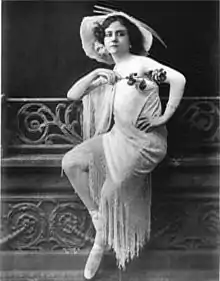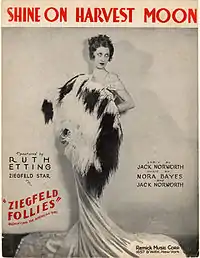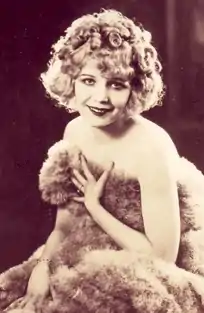Ziegfeld Follies
The Ziegfeld Follies was a series of elaborate theatrical revue productions on Broadway in New York City from 1907 to 1931, with renewals in 1934 and 1936. They became a radio program in 1932 and 1936 as The Ziegfeld Follies of the Air.



Founding and history
Inspired by the Folies Bergère of Paris, the Ziegfeld Follies were conceived and mounted by Florenz Ziegfeld Jr., reportedly at the suggestion of his then-wife, the stage actress and singer Anna Held. The shows' producers were turn-of-the-twentieth-century producing titans Klaw and Erlanger.
The Follies were a series of lavish revues, something between later Broadway shows and the more elaborate high class vaudeville and variety show. The first Follies was produced in 1907 at the roof theatre Jardin de Paris.[1]
During the Follies era, many of the top entertainers, including W. C. Fields, Eddie Cantor, Josephine Baker, Fanny Brice, Ann Pennington, Bert Williams, Eva Tanguay, Bob Hope, Will Rogers, Ruth Etting, Ray Bolger, Helen Morgan, Louise Brooks, Marilyn Miller, Ed Wynn, Gilda Gray, Nora Bayes and Sophie Tucker appeared in the shows.[2]
The Ziegfeld Follies were also famous for their display of many beautiful chorus girls, commonly known as Ziegfeld Girls, who "paraded up and down flights of stairs as anything from birds to battleships."[3] They usually wore elaborate costumes by designers such as Erté, Lady Duff Gordon and Ben Ali Haggin.
The "tableaux vivants" were designed by Ben Ali Haggin from 1917 to 1925. Joseph Urban was the scenic designer for the Follies shows starting in 1915.[4]
After Ziegfeld's death his widow, actress Billie Burke, authorized use of his name for Ziegfeld Follies in 1934 and 1936 to Jake Shubert, who then produced the Follies.[5] The name was later used by other promoters in New York City, Philadelphia, and again on Broadway, with less connection to the original Follies. These later efforts failed miserably. When the show toured, the 1934 edition was recorded in its entirety, from the overture to play-out music, on a series of 78 rpm discs, which were edited by the record producer David Cunard to form an album of the highlights of the production and which was released as a CD in 1997.
Films based on the Ziegfeld Follies

In 1937, at the 9th Academy Awards, the Metro-Goldwyn-Mayer film, The Great Ziegfeld produced the previous year won the Best Picture (called "Outstanding Production"),[6][7] starring William Powell as Florenz Ziegfeld, Jr. and co-starring Myrna Loy (as Ziegfeld's second wife Billie Burke), Luise Rainer (as Anna Held, which won her an Academy Award for Best Actress),[6] and Frank Morgan as Jack Billings.[8] Featuring numbers by Ray Bolger, Dennis Morgan, Virginia Bruce, and Harriet Hoctor, the film gave a glimpse into what the Follies were really like. The show-stopper was the Irving Berlin-composed "A Pretty Girl Is Like a Melody", which, by itself, cost more to produce than one of Ziegfeld's entire stage shows.[7]
In 1941 MGM released Ziegfeld Girl, starring Judy Garland, Lana Turner, Hedy Lamarr, James Stewart and Tony Martin. The film was set in the 1920s.[9] Celebrated numbers from Ziegfeld Revues were recreated, including the famed "Wedding Cake" set which had been used for Metro's earlier film, The Great Ziegfeld. Judy Garland was filmed on the top of the cake.[10] Charles Winninger, who had performed in the Follies of 1920, appeared as "Ed Gallagher" [9] with Gallagher's real-life partner, Al Shean to recreate the duo's famous song "Mister Gallagher and Mister Shean".[11] According to modern sources, Turner's character was modeled after Ziegfeld Girl Lillian Lorraine, who suffered a drunken fall into the orchestra pit during an extravagant number.[12]
In 1946 MGM released a third feature film based on Ziegfeld's shows titled Ziegfeld Follies with Fred Astaire, Judy Garland, Lena Horne, William Powell (as Ziegfeld), Gene Kelly, Fanny Brice, Red Skelton, Esther Williams, Cyd Charisse, Lucille Ball, Kathryn Grayson, and others performing songs and sketches similar to those from the original Follies. Ziegfeld Follies was awarded the "Grand Prix de la Comedie Musicale" at the Cannes Film Festival in 1947, and received an Academy Award nomination for Best Art Direction-Set Decoration (black and white).[13]
The 1964 stage musical Funny Girl,[14] starring Barbra Streisand as Fanny Brice, depicts Fanny Brice's success with the Follies. The 1968 Columbia Pictures film of Funny Girl also starred Barbra Streisand as Brice and Walter Pidgeon as Florenz Ziegfeld.[15]
The Follies
- Follies of 1907, 1908, 1909, 1910 at the Jardin de Paris
- Ziegfeld Follies of 1911 at the Jardin de Paris
- Ziegfeld Follies of 1912 at the Moulin Rouge
- Ziegfeld Follies of 1913, 1914, 1915, 1916, 1917, 1918, 1919, 1920 at the New Amsterdam Theatre
- Ziegfeld Follies of 1921 at the Globe Theatre
- Ziegfeld Follies of 1922, 1923, 1924, 1925, 1927 at the New Amsterdam Theatre
- Ziegfeld Follies of 1931 at the Ziegfeld Theatre
- Ziegfeld Follies of 1934 at the Winter Garden Theatre
- Ziegfeld Follies of 1936 at the Winter Garden Theatre
- Ziegfeld Follies of 1943, 1957 at the Winter Garden Theatre
Performers: year-by-year
|
|
|
|
Ziegfeld girls
 Ruth Etting of the Ziegfeld Follies
Ruth Etting of the Ziegfeld Follies Muriel Finlay, Ziegfeld girl, by Alfred Cheney Johnston, ca. 1928
Muriel Finlay, Ziegfeld girl, by Alfred Cheney Johnston, ca. 1928 A photograph of Doris Eaton Travis (1904-2010) in about 1920, during the Ziegfeld Follies years.
A photograph of Doris Eaton Travis (1904-2010) in about 1920, during the Ziegfeld Follies years. Marion Davies, Ziegfeld girl, by Alfred Cheney Johnston, 1924
Marion Davies, Ziegfeld girl, by Alfred Cheney Johnston, 1924 Fanny Brice, Ziegfeld Follies photo, 1910s or start of 1920s
Fanny Brice, Ziegfeld Follies photo, 1910s or start of 1920s Shannon Day
Shannon Day Mary Eaton
Mary Eaton Billie Dove
Billie Dove Dancer Bee Palmer in fur
Dancer Bee Palmer in fur Barbara Stanwyck
Barbara Stanwyck Dolores Costello
Dolores Costello
Adaptations / In popular culture
The 1912 version of the Ziegfeld Follies included a song entitled Row, Row, Row, which has been adapted by two football clubs in two different codes as its club song.
In 1962, cabaret singer Jack Malcolmson, who was performing at the Richmond Football Club (Australian rules) Social Club in Richmond, Melbourne, adapted the song into the Tigers' new club song, We're From Tigerland, at the request of Richmond committee member Alf Barnett. (Previously, Richmond's club song had been Onward The Tigers, to the tune of Waltzing Matilda.) In 2014, Melbourne's Herald Sun ranked We're From Tigerland as the best club song of any Australian Football League team.[21] Official versions of the song include a 1972 recording by the Fable Singers, who recorded most AFL club songs, and a 2018 recording including Richmond legends Matthew Richardson and Kevin Bartlett.[22]
Row, Row, Row has also been adapted by America Football Club in Rio de Janeiro as its anthem, the Hino do America, with America supporter and famous Brazilian composer Lamartine Babo helping adapt the song.[23]
The 1971 Stephen Sondheim musical Follies takes place at a reunion of showgirls from the Weissman Follies, a fictional revue inspired by the Ziegfeld Follies. In addition to featuring "ghosts" of statuesque showgirls from the heyday of the revues, the musical includes many songs and production numbers that are intended to evoke the types of entertainment typically featured in the Ziegfeld Follies and other revues of the period. Examples include parade of showgirls ("Beautiful Girls"); a torch song (Losing My Mind); a baggy pants comic song ("The God-Why-Don't-You-Love-Me Blues"); and a novelty song ("Rain on the Roof").
In The Drowsy Chaperone there is a character by the name of Victor Feldzieg, the producer of Feldzieg's Follies, a parody of Ziegfeld Follies.
See also
References
- "Follies of 1907"The New York Times, July 9, 1907
- "Flo Ziegfeld-Billie Burke Papers" nypl.org, accessed December 3, 2011
- "Ziegfeld Biography" pbs.org, accessed December 3, 2011
- Green, Stanley."Ziegfeld"Encyclopedia of the Musical Theatre (1980), Da Capo Press, ISBN 0-306-80113-2, pp.462-465
- Bloom, Ken."Winter Garden Theatre" The Routledge Guide to Broadway (2007), CRC Press, ISBN 0-415-97380-5, p. 273
- "Ceremonies 1937" oscars.org, retrieved June 16, 2019
- "Notes" tcm.com, retrieved June 16, 2019
- "'The Great Ziegfeld' Overview, Cast and Synopsis" tcm.com, retrieved June 16, 2019
- " 'Ziegfeld Girl' Overview and Cast" tcm.com, retrieved June 16, 2019
- " 'Ziegfeld Girl' Notes" tcm.com, retrieved June 16, 2019
- "Ziegfeld Girl" Library of Congress, retrieved June 17, 2019
- The Ziegfeld Girl entry, AFI Catalog of Feature Films, 1941-1950; accessed October 2, 2016.
- " 'Ziegfeld Follies' Overview and Cast" tcm.com, retrieved June 16, 2019
- The Broadway League. "Funny Girl". www.ibdb.com. Retrieved 2016-04-21.
- " Funny Girl Credits" tcm.com, retrieved June 16, 2019
- "Granville, Actor, Dies In Hollywood". The New York Times. October 7, 1936. Retrieved 2015-01-28.
Film Comedian Well Known on New York Stage for Many Years Victim of Pneumonia. Long Career Included Roles in Minstrel Shows, Circuses and Outstanding Plays
- Massa, Steve (2013). Lame Brains & Lunatics: The Good, the Bad, and the Forgotten of Silent Comedy. Albany, Georgia: BearManor Media. pp. 88–91. ISBN 978-1-59393-268-8.
- Motion Pictures Studio Directory and Trade Annual (1921), p. 209 ("stage career, "Follies," 1917-18; "The Frolic," 1919")
- "The 'Follies of 1917' Are Coming to Town" New York Times (June 10, 1917): 79. via ProQuest
- "William E. Ritchie, Trick Bicyclist, 70?. Vaudeville and Revue Artist Dies Here. Had Played With Will Rogers, W. C. Fields. In Stage Team with Wife. He and May Villion on Tour for Many Years. Were in 'The Follies' of 1917–1918". The New York Times. May 13, 1943.
- "Every AFL song ranked from best to worst". Retrieved 2017-09-30.
- Tigers tune-up for Club song Richmond Football Club
- Famoso hino do America é um plágio, conclui professor de música da UFRJ (Portuguese) Globo E Sporte
External links
| Wikimedia Commons has media related to Ziegfeld Follies. |